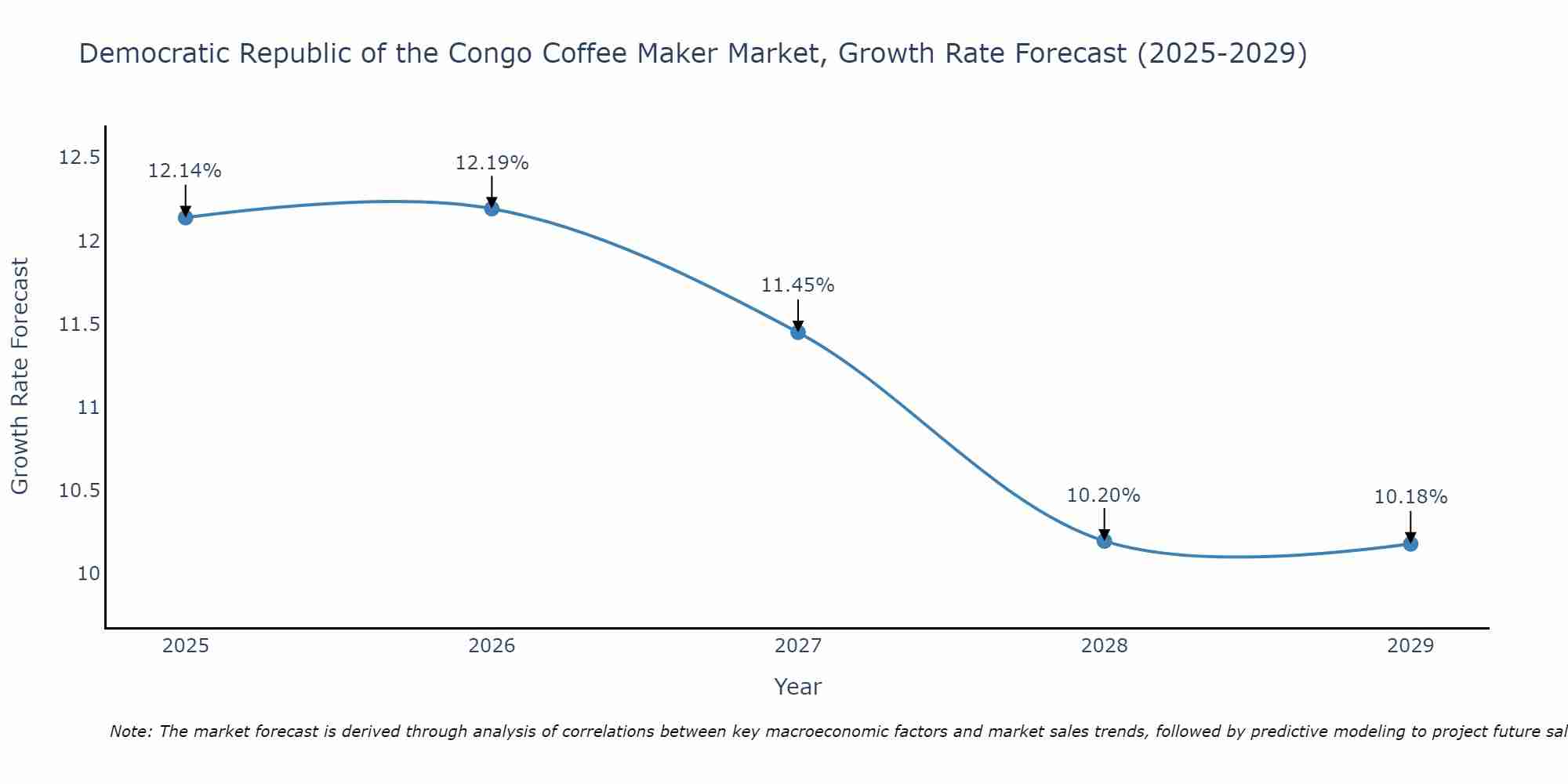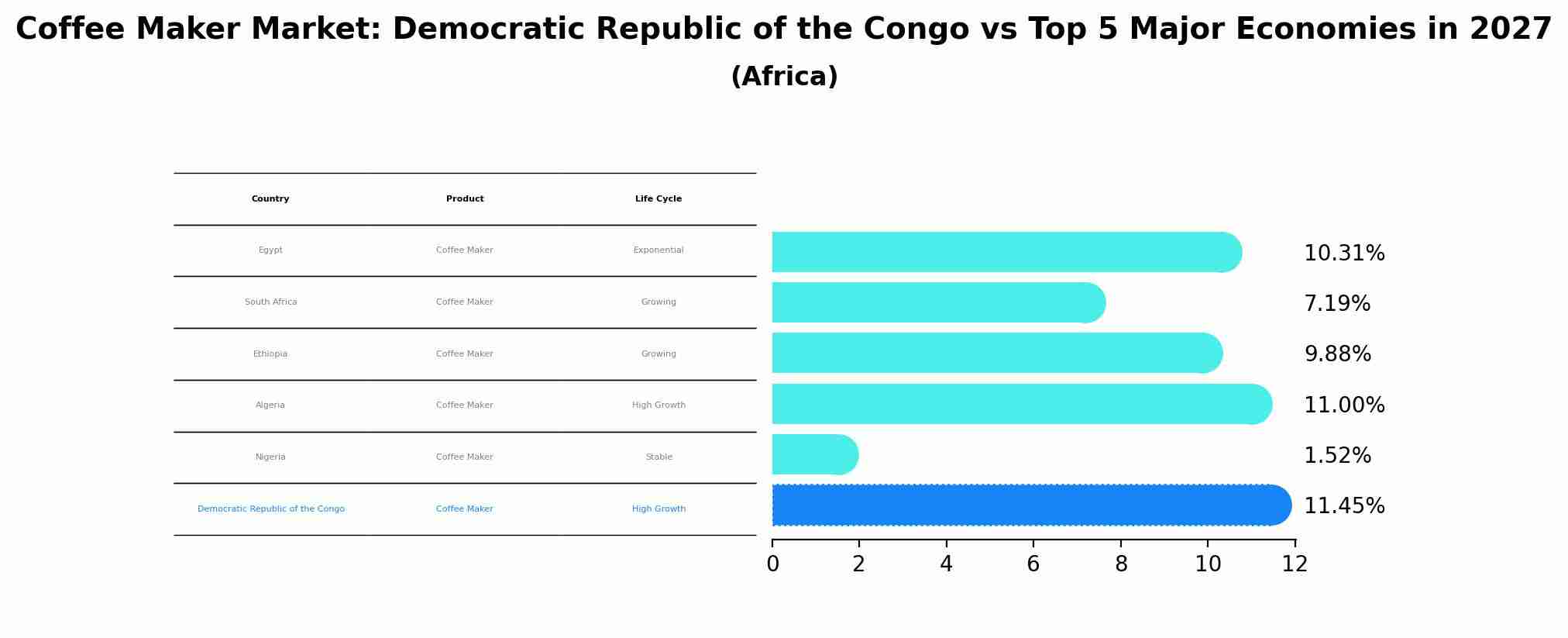Congo Coffee Maker Market (2025-2031) | Analysis, Size, Companies, Industry, Forecast, Value, Share, Outlook, Growth, Segmentation, Trends & Revenue
| Product Code: ETC4797994 | Publication Date: Nov 2023 | Updated Date: Apr 2025 | Product Type: Market Research Report | |
| Publisher: 6Wresearch | Author: Sachin Kumar Rai | No. of Pages: 60 | No. of Figures: 30 | No. of Tables: 5 |
Democratic Republic of the Congo Coffee Maker Market Size Growth Rate
The Democratic Republic of the Congo Coffee Maker Market is projected to witness mixed growth rate patterns during 2025 to 2029. Growth accelerates to 12.19% in 2026, following an initial rate of 12.14%, before easing to 10.18% at the end of the period.

Coffee Maker Market: Democratic Republic of the Congo vs Top 5 Major Economies in 2027 (Africa)
The Coffee Maker market in Democratic Republic of the Congo is projected to grow at a high growth rate of 11.45% by 2027, within the Africa region led by Egypt, along with other countries like South Africa, Ethiopia, Algeria and Nigeria, collectively shaping a dynamic and evolving market environment driven by innovation and increasing adoption of emerging technologies.

Congo Coffee Maker Market Overview
The Congo coffee maker market is evolving with the increasing demand for various types of coffee machines, including drip coffee makers, espresso machines, and single-serve brewers. The market growth is driven by a rising coffee culture and consumer preference for home brewing. Challenges include limited local production of coffee makers, high import costs, and competition from international brands. Developing local manufacturing capabilities and enhancing product availability can help boost the market.
Drivers of the market
The Congo coffee maker market is influenced by the rising coffee consumption and the demand for convenient coffee preparation solutions. The growing number of coffee shops and households seeking advanced coffee-making appliances drives market growth. Innovations in coffee maker technology, such as programmable features and built-in grinders, enhance consumer appeal. Additionally, the increasing availability of coffee makers through various retail channels and the growing interest in home brewing contribute to the market`s expansion.
Challenges of the market
The Congo Coffee Maker Market faces challenges related to both supply and demand. There is limited local manufacturing capacity, leading to reliance on imported coffee makers, which increases costs and affects affordability. Additionally, the market faces issues with consumer awareness and preferences, as coffee culture is still developing in Congo. Inadequate distribution networks and infrastructure further hinder the availability and accessibility of coffee makers in the market.
Government Policy of the market
The coffee maker market in Congo benefits from government policies focused on technological advancement and consumer protection. The government encourages investment in modern coffee-making technologies through grants and subsidies. Regulations ensure that coffee makers meet safety and performance standards, which is important for consumer confidence. There are also efforts to support local manufacturing and assembly of coffee makers to reduce import dependency and create job opportunities. Policies aimed at improving infrastructure and logistics further facilitate the growth of the coffee maker market by ensuring efficient distribution and accessibility.
Key Highlights of the Report:
- Congo Coffee Maker Market Outlook
- Market Size of Congo Coffee Maker Market, 2024
- Forecast of Congo Coffee Maker Market, 2031
- Historical Data and Forecast of Congo Coffee Maker Revenues & Volume for the Period 2021-2031
- Congo Coffee Maker Market Trend Evolution
- Congo Coffee Maker Market Drivers and Challenges
- Congo Coffee Maker Price Trends
- Congo Coffee Maker Porter`s Five Forces
- Congo Coffee Maker Industry Life Cycle
- Historical Data and Forecast of Congo Coffee Maker Market Revenues & Volume By Types for the Period 2021-2031
- Historical Data and Forecast of Congo Coffee Maker Market Revenues & Volume By Drip Coffee Machine for the Period 2021-2031
- Historical Data and Forecast of Congo Coffee Maker Market Revenues & Volume By Steam Coffee Machine for the Period 2021-2031
- Historical Data and Forecast of Congo Coffee Maker Market Revenues & Volume By Capsule Coffee Machine for the Period 2021-2031
- Historical Data and Forecast of Congo Coffee Maker Market Revenues & Volume By Others for the Period 2021-2031
- Historical Data and Forecast of Congo Coffee Maker Market Revenues & Volume By End-users for the Period 2021-2031
- Historical Data and Forecast of Congo Coffee Maker Market Revenues & Volume By Commercial for the Period 2021-2031
- Historical Data and Forecast of Congo Coffee Maker Market Revenues & Volume By Industrial for the Period 2021-2031
- Historical Data and Forecast of Congo Coffee Maker Market Revenues & Volume By Distribution Channel for the Period 2021-2031
- Historical Data and Forecast of Congo Coffee Maker Market Revenues & Volume By Online for the Period 2021-2031
- Historical Data and Forecast of Congo Coffee Maker Market Revenues & Volume By Offline for the Period 2021-2031
- Congo Coffee Maker Import Export Trade Statistics
- Market Opportunity Assessment By Types
- Market Opportunity Assessment By End-users
- Market Opportunity Assessment By Distribution Channel
- Congo Coffee Maker Top Companies Market Share
- Congo Coffee Maker Competitive Benchmarking By Technical and Operational Parameters
- Congo Coffee Maker Company Profiles
- Congo Coffee Maker Key Strategic Recommendations
Frequently Asked Questions About the Market Study (FAQs):
1 Executive Summary |
2 Introduction |
2.1 Key Highlights of the Report |
2.2 Report Description |
2.3 Market Scope & Segmentation |
2.4 Research Methodology |
2.5 Assumptions |
3 Congo Coffee Maker Market Overview |
3.1 Congo Country Macro Economic Indicators |
3.2 Congo Coffee Maker Market Revenues & Volume, 2021 & 2031F |
3.3 Congo Coffee Maker Market - Industry Life Cycle |
3.4 Congo Coffee Maker Market - Porter's Five Forces |
3.5 Congo Coffee Maker Market Revenues & Volume Share Segmentations, 2021 & 2031F |
3.6 Congo Coffee Maker Market Revenues & Volume Share, By End-users, 2021 & 2031F |
3.7 Congo Coffee Maker Market Revenues & Volume Share, By Distribution Channel, 2021 & 2031F |
4 Congo Coffee Maker Market Dynamics |
4.1 Impact Analysis |
4.2 Market Drivers |
4.3 Market Restraints |
5 Congo Coffee Maker Market Trends |
6 Congo Coffee Maker Market Segmentations |
6.1 Congo Coffee Maker Market Segmentations |
6.1.1 Overview and Analysis |
6.1.2 Congo Coffee Maker Market Revenues & Volume, By Drip Coffee Machine, 2021-2031F |
6.1.3 Congo Coffee Maker Market Revenues & Volume, By Steam Coffee Machine, 2021-2031F |
6.1.4 Congo Coffee Maker Market Revenues & Volume, By Capsule Coffee Machine, 2021-2031F |
6.1.5 Congo Coffee Maker Market Revenues & Volume, By Others, 2021-2031F |
6.2 Congo Coffee Maker Market, By End-users |
6.2.1 Overview and Analysis |
6.2.2 Congo Coffee Maker Market Revenues & Volume, By Commercial, 2021-2031F |
6.2.3 Congo Coffee Maker Market Revenues & Volume, By Industrial, 2021-2031F |
6.3 Congo Coffee Maker Market, By Distribution Channel |
6.3.1 Overview and Analysis |
6.3.2 Congo Coffee Maker Market Revenues & Volume, By Online, 2021-2031F |
6.3.3 Congo Coffee Maker Market Revenues & Volume, By Offline, 2021-2031F |
7 Congo Coffee Maker Market Import-Export Trade Statistics |
7.1 Congo Coffee Maker Market Export to Major Countries |
7.2 Congo Coffee Maker Market Imports from Major Countries |
8 Congo Coffee Maker Market Key Performance Indicators |
9 Congo Coffee Maker Market - Opportunity Assessment |
9.1 Congo Coffee Maker Market Opportunity Assessment Segmentations, 2021 & 2031F |
9.2 Congo Coffee Maker Market Opportunity Assessment, By End-users, 2021 & 2031F |
9.3 Congo Coffee Maker Market Opportunity Assessment, By Distribution Channel, 2021 & 2031F |
10 Congo Coffee Maker Market - Competitive Landscape |
10.1 Congo Coffee Maker Market Revenue Share, By Companies, 2024 |
10.2 Congo Coffee Maker Market Competitive Benchmarking, By Operating and Technical Parameters |
11 Company Profiles |
12 Recommendations | 13 Disclaimer |
- Single User License$ 1,995
- Department License$ 2,400
- Site License$ 3,120
- Global License$ 3,795
Search
Related Reports
- Middle East OLED Market (2025-2031) | Outlook, Forecast, Revenue, Growth, Companies, Analysis, Industry, Share, Trends, Value & Size
- Taiwan Electric Truck Market (2025-2031) | Outlook, Industry, Revenue, Size, Forecast, Growth, Analysis, Share, Companies, Value & Trends
- South Korea Electric Bus Market (2025-2031) | Outlook, Industry, Companies, Analysis, Size, Revenue, Value, Forecast, Trends, Growth & Share
- Vietnam Electric Vehicle Charging Infrastructure Market (2025-2031) | Outlook, Analysis, Forecast, Trends, Growth, Share, Industry, Companies, Size, Value & Revenue
- Vietnam Meat Market (2025-2031) | Companies, Industry, Forecast, Value, Trends, Analysis, Share, Growth, Revenue, Size & Outlook
- Vietnam Spices Market (2025-2031) | Companies, Revenue, Share, Value, Growth, Trends, Industry, Forecast, Outlook, Size & Analysis
- Iran Portable Fire Extinguisher Market (2025-2031) | Value, Forecast, Companies, Industry, Analysis, Trends, Growth, Revenue, Size & Share
- Philippines Animal Feed Market (2025-2031) | Companies, industry, Size, Share, Revenue, Analysis, Forecast, Growth, Outlook
- India Lingerie Market (2025-2031) | Companies, Growth, Forecast, Outlook, Size, Value, Revenue, Share, Trends, Analysis & Industry
- India Smoke Detector Market (2025-2031) | Trends, Share, Analysis, Revenue, Companies, Industry, Forecast, Size, Growth & Value
Industry Events and Analyst Meet
Our Clients
Whitepaper
- Middle East & Africa Commercial Security Market Click here to view more.
- Middle East & Africa Fire Safety Systems & Equipment Market Click here to view more.
- GCC Drone Market Click here to view more.
- Middle East Lighting Fixture Market Click here to view more.
- GCC Physical & Perimeter Security Market Click here to view more.
6WResearch In News
- Doha a strategic location for EV manufacturing hub: IPA Qatar
- Demand for luxury TVs surging in the GCC, says Samsung
- Empowering Growth: The Thriving Journey of Bangladesh’s Cable Industry
- Demand for luxury TVs surging in the GCC, says Samsung
- Video call with a traditional healer? Once unthinkable, it’s now common in South Africa
- Intelligent Buildings To Smooth GCC’s Path To Net Zero













